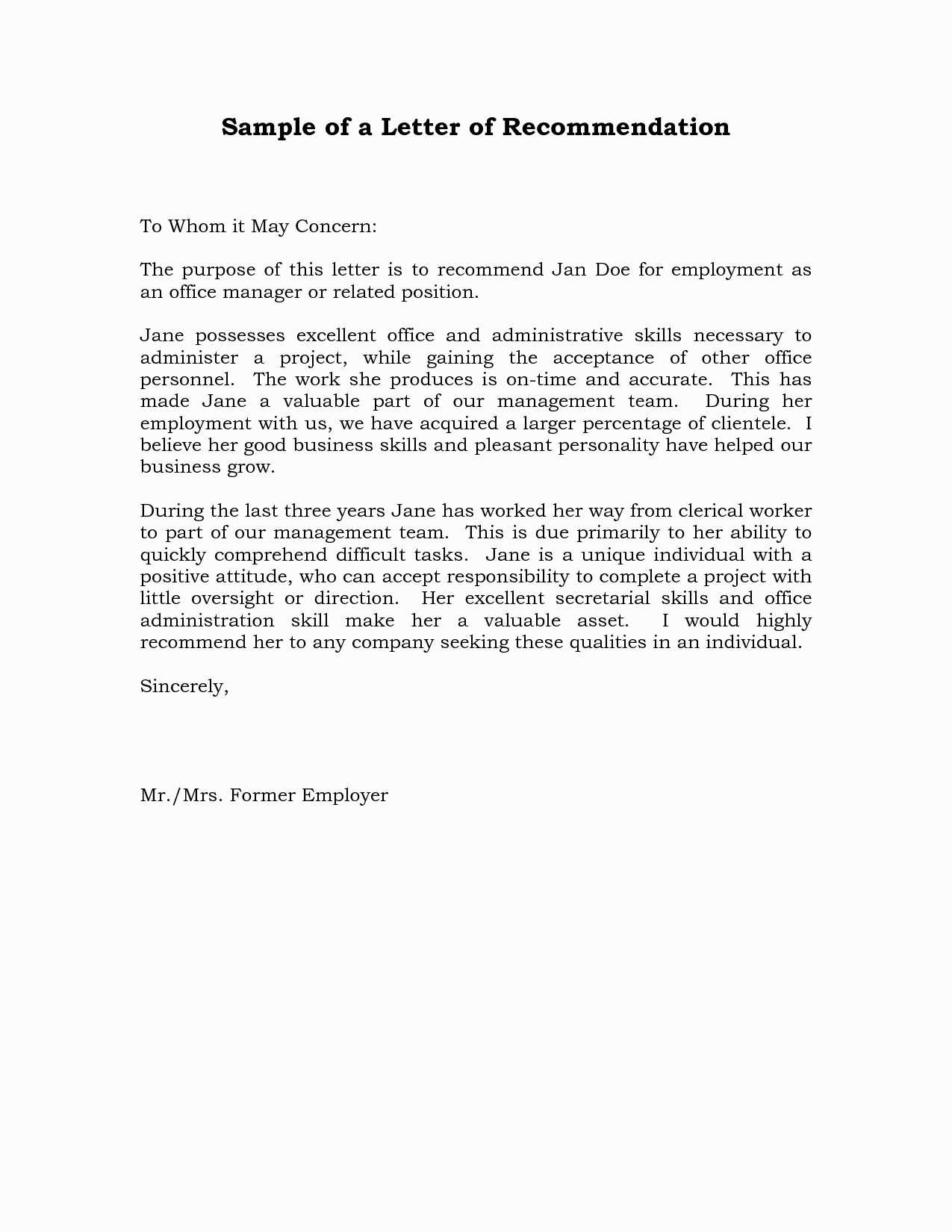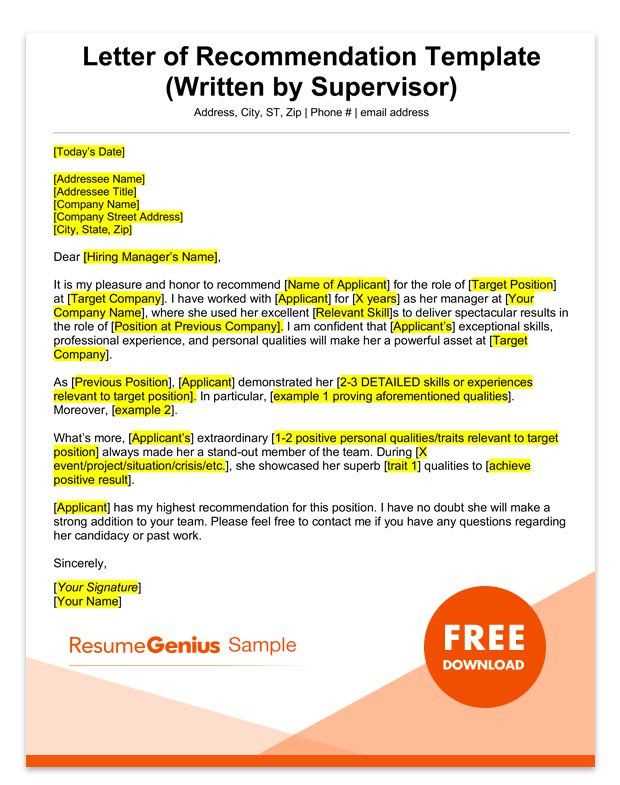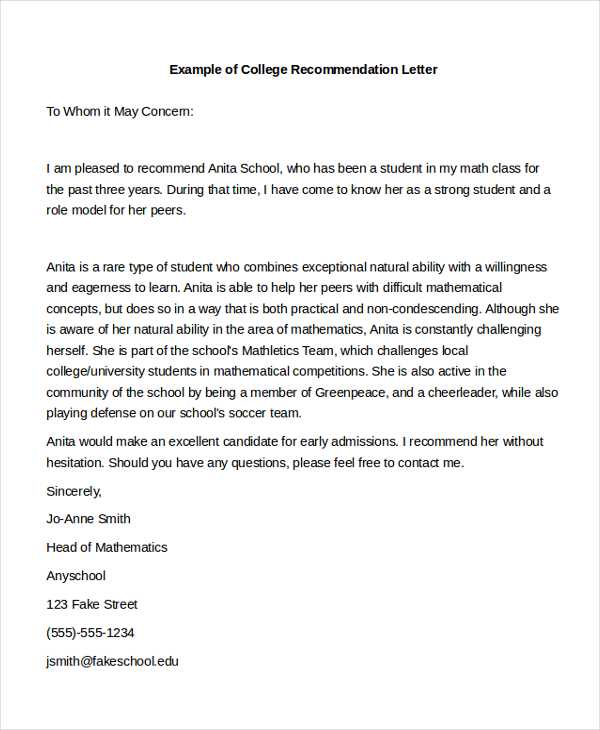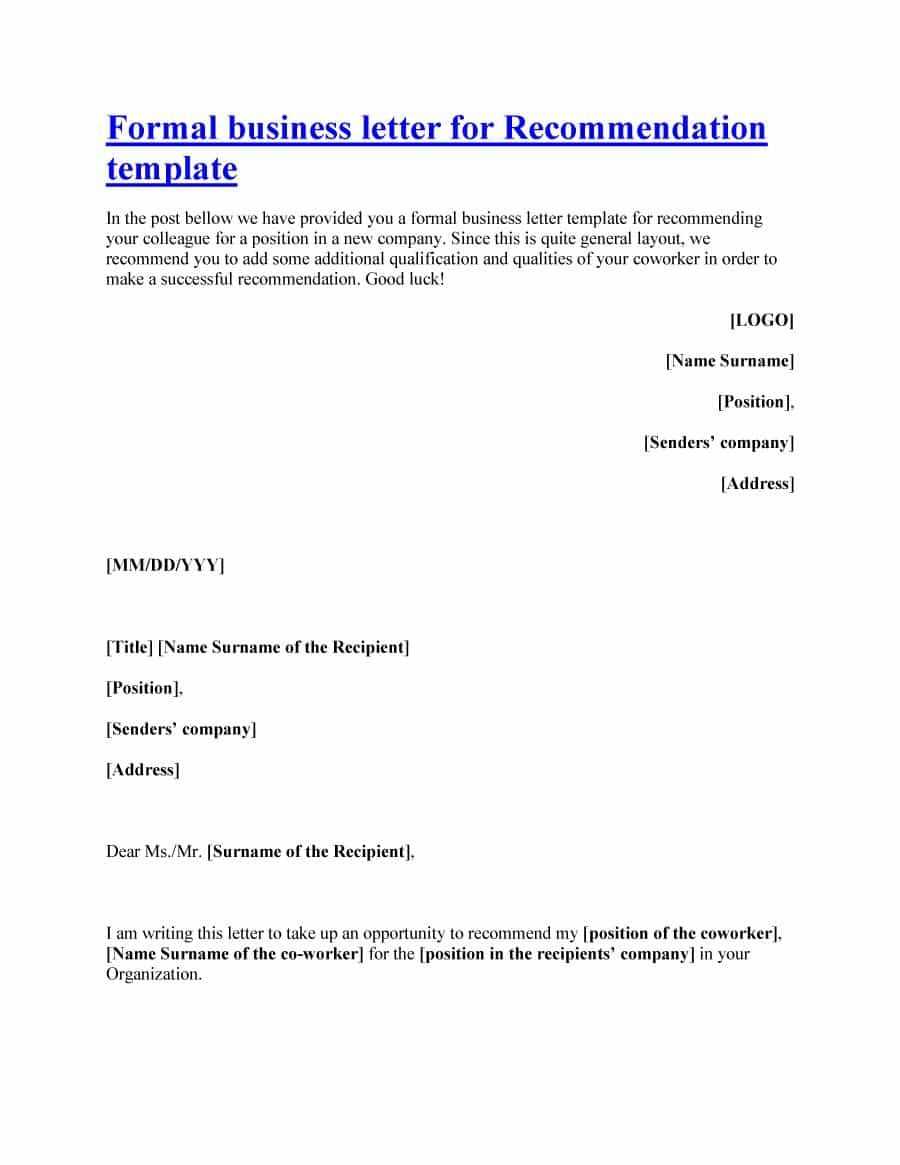Template letter recommendation

If you’re preparing to write a recommendation letter, it’s important to address the key strengths of the person you’re recommending. Start by identifying the individual’s specific achievements, skills, and characteristics that make them a strong candidate for the opportunity they are pursuing. Mention how these qualities set them apart from others in their field or area of expertise.
Ensure that you provide concrete examples to support your claims. For instance, if you’re recommending someone for a job, describe how their performance in previous roles directly contributed to the success of the organization. Use detailed observations rather than general statements, which will give your letter credibility and create a strong impression.
Make sure to emphasize the person’s personal qualities that complement their professional skills. Traits such as reliability, teamwork, and problem-solving abilities can all play a significant role in demonstrating why this person should be considered. Your letter should leave no doubt in the reader’s mind about their potential.
Finally, close the letter with a clear recommendation. Restate your confidence in the individual’s ability to succeed and provide your contact information for follow-up questions. A strong, concise conclusion reinforces your support and leaves the reader with a lasting impression of the individual’s value.
Template Letter Recommendation
For anyone seeking a well-structured recommendation letter, here is a template that can be adapted to suit various situations. The letter should start with a clear acknowledgment of the relationship between the recommender and the person being recommended.
“I have had the pleasure of working closely with [Name] for [length of time] in my capacity as [your job title or relationship]. During this period, [Name] demonstrated exceptional skills in [specific area or task], consistently exceeding expectations. [He/She/They] proved to be a dedicated and reliable individual, consistently meeting deadlines and contributing significantly to the team’s success.”
Next, highlight the candidate’s strengths and specific achievements. Focus on tangible results or qualities that align with the position or opportunity they are pursuing.
“[Name] is particularly skilled in [mention key skills or traits relevant to the opportunity]. One example of this was when [he/she/they] successfully [describe a specific achievement or situation that showcases their abilities]. This accomplishment not only demonstrated [his/her/their] expertise in [relevant skill], but also [his/her/their] ability to collaborate effectively with others, a crucial aspect of [specific field or role].”
Conclude the letter with a strong recommendation. Be specific and direct in your endorsement.
“Without reservation, I recommend [Name] for [the opportunity or position]. I am confident that [he/she/they] will bring the same level of dedication, skill, and passion to [his/her/their] next role. Please feel free to contact me at [your contact information] if you require any additional information.”
By following this structure, you can create a recommendation letter that is both informative and compelling, providing a clear picture of the individual’s qualifications and suitability for the opportunity.
How to Structure a Strong Letter Recommendation
Begin with a clear and concise introduction. State the purpose of the letter and how you know the person you’re recommending. Focus on specific qualities that stand out, backed by concrete examples.
Opening Paragraph
In the first few sentences, briefly introduce the candidate and your relationship to them. Mention the length and context of your relationship to establish credibility. Avoid generalities and focus on their strengths with a specific example from your experience.
Body Paragraphs
Describe the candidate’s qualities in detail. Each paragraph should focus on one attribute, supported by real-life situations. Show how these qualities make the individual stand out in their field or role. Don’t just state that the candidate is “hardworking” or “intelligent”–explain how these traits have manifested in their actions and achievements. Include metrics or results when possible.
For instance, if you’re recommending someone for a leadership role, illustrate their ability to lead by describing a successful project or team they managed. The more specific you can be, the more compelling your recommendation will be.
Conclude with a final paragraph that reinforces your confidence in the candidate’s abilities. Avoid vague phrases; instead, reassert the key reasons why you believe they are an excellent choice. Include an offer to provide further details if necessary, giving the reader an opportunity to reach out for more information.
Choosing the Right Tone and Language for Your Audience
When writing a recommendation letter, match the tone and language to the recipient’s expectations. A formal letter directed to a potential employer should use a respectful and professional tone. Avoid overly casual language, but keep the wording clear and straightforward. On the other hand, a recommendation for a close colleague or friend can be warmer and more conversational, while still maintaining a sense of respect.
Understanding the Recipient’s Expectations

Research the recipient’s background or organization to understand the level of formality needed. If you’re recommending someone for a corporate position, keep the tone more businesslike. If the letter is for a volunteer position or a community event, feel free to adopt a friendlier, more enthusiastic tone. Adapting to the recipient’s environment helps establish a strong connection.
Adjusting Your Vocabulary and Phrasing

Choose words that reflect the values of the recipient’s field. For example, a letter for an academic position may include more technical language related to education or research. A recommendation for a creative position could be more expressive, highlighting the individual’s innovation or artistic contributions. Tailor the language to align with the expectations of the specific field or profession.
Highlighting Key Skills and Achievements in the Letter
Focus on the applicant’s top skills and specific achievements. Instead of general qualities, provide measurable outcomes and specific examples. For instance, mention how the person increased sales by 20% within six months or led a successful project team that delivered results ahead of schedule. These details show their direct contribution to the organization’s success.
Specific Examples of Achievements
Provide concrete examples of the applicant’s work that align with the position they are applying for. Quantify their success when possible. For example, if the person improved customer satisfaction, state how it was measured and the percentage increase. It’s beneficial to show how the applicant solved problems effectively or exceeded expectations in their role.
Key Skills Demonstrated
Highlight the applicant’s skills that directly relate to the job they are being recommended for. Mention skills like leadership, problem-solving, or technical expertise with specific instances where these abilities were applied. For example, demonstrate how the applicant’s leadership improved team collaboration or their technical knowledge helped streamline processes.
| Skill | Example |
|---|---|
| Leadership | Led a team to complete a project ahead of schedule, resulting in a 10% increase in client satisfaction. |
| Problem-solving | Resolved a major operational issue, saving the company 15% in costs annually. |
| Communication | Successfully coordinated between departments, improving project flow and reducing delays by 30%. |
Ensuring Clarity and Conciseness in Your Writing

Use clear and straightforward language. Avoid long-winded sentences and unnecessary details that may distract the reader. Focus on communicating your point in a direct manner. Each sentence should serve a specific purpose without adding fluff.
Keep Sentences Short and Direct
Short sentences are easier to follow. Break up complex ideas into simple, digestible parts. This helps readers grasp your message quickly without getting lost in lengthy explanations.
Eliminate Redundancy
Review your letter for repetition. Remove phrases or words that restate the same idea without adding value. A concise letter keeps the reader engaged and ensures your message doesn’t get lost in excess verbiage.
Addressing Potential Concerns or Weaknesses in a Positive Light
Highlight the ways in which any challenges or areas of improvement are being actively addressed. Present them as opportunities for growth rather than setbacks.
Addressing Time Management Challenges
If time management has been an issue, focus on the individual’s commitment to improvement. Mention any tools they have implemented, such as planners or digital apps, to better manage tasks and deadlines. Their willingness to seek feedback and adjust their methods shows their dedication to becoming more organized.
Improving Communication Skills
If communication was previously a concern, emphasize how the individual has taken steps to develop their skills. Whether they have attended workshops, sought mentorship, or actively worked on improving their written or verbal communication, these efforts reflect their commitment to continuous improvement.
- Participating in team discussions more regularly
- Seeking clarification when needed to avoid misunderstandings
- Actively listening and providing constructive feedback
These actions demonstrate a growth mindset and a focus on becoming a stronger communicator.
Personalizing the Template for Specific Situations or Roles
Adjust the letter to reflect the candidate’s qualifications and how they align with the specific requirements of the role. Begin by addressing the skills, experiences, and attributes that are most relevant to the position being applied for. Tailor your language to highlight how the candidate’s background fits the employer’s expectations.
Focusing on Relevant Skills and Achievements
For a technical role, emphasize the candidate’s technical expertise, certifications, and problem-solving abilities. For a leadership position, discuss their experience in managing teams, making strategic decisions, and driving project success. Each section of the letter should mirror the key responsibilities and expectations outlined in the job description.
Including Examples that Reflect the Role’s Demands
Personalize the letter by incorporating specific examples that showcase the candidate’s success in similar roles. This demonstrates a clear connection between their past experiences and what the company needs. Use metrics or outcomes to give context and provide measurable evidence of their capabilities.